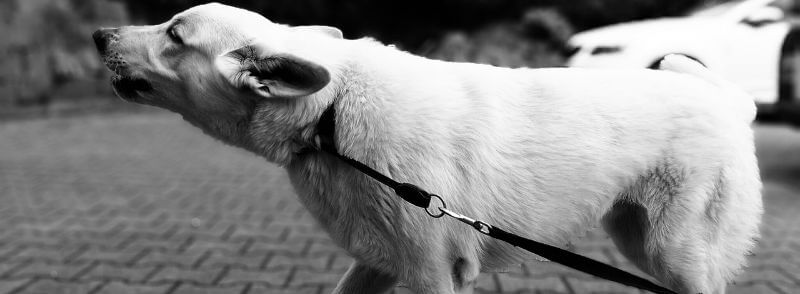Getting the Dog Not to Pull on a Leash
How to Stop the Dog Pulling on the Leash When Walking Him:
Your young dog is confident when he goes out that the world is wonderful and doesn’t contain anything that shouldn’t be checked out and investigated. How does he check? He gets close, smells, maybe tries to chew or poke something with his paw. If he is a young male you may safely assume that at about 15 months of age he will start to put his mark on every post and tree in the street. Only by urination he says ‘I was here’. There is no doubt that your empathy with him is what makes you follow in his footsteps and allow him to lead the way. If things go on this way don’t be surprised if he drags you where, when and how he wants to and you find yourself slave to his whims. From the dog’s point of view, the pack leader heads the caravan. When dogs lived in packs and went out hunting, only the leader had the authority to determine the pace. If another dog tried to overtake the leader he would be firmly put in his place with a fierce growl. In light of this, the dog must learn by correct training that there is only one boss in your pack, and that it is not him. Don’t worry; this won’t frustrate him as dogs don’t have problems of self esteem, only problems with unclear definitions of hierarchy. This rule applies anywhere you may be with the dog: you must be the first one to go out of the house when going for a walk; you are the one to get out of the car first, and the first to enter the house when you return home. The dog should always be either at your side or behind you as it was in nature, and never ahead of you.
Another tip – you know those expanding leads that can stretch to 3 or even 5 metres and automatically shorten when the dog comes near you? Don’t use them! There is no chance that your dog will learn to be obedient if he is so far away from you. In recent years equipment has been sold that purports to be an alternative to the slip chain, which binds the head or body of the dog with a type of harness. This equipment has no positive effect. At best these harnesses don’t encourage your dog to listen to you and at worst can cause chafing and damage to his neck.
What to use? For the first stage of training use what is unjustly called a ‘choke’ chain. Why unjustly? Because the chain only chokes when used incorrectly. This collar is properly called a slip chain and is made of metal links. It should fit around the dog’s neck with a leeway of about 15cm. You will also need a leash about 1.8 metres in length.
Go out for a walk with the dog. Start by having the dog on your left side, the leash in your right hand at about your waist height and held loosely. If the dog begins to go ahead of you, don’t stop walking and don’t pull on the leash until it is stretched taut. A moment before the leash is stretched as taut as possible and the slip chain begins to tighten on the dog’s neck, jerk the leash with a short sharp pull, at the same time give the command ‘no’ in a clear, sharp voice. The dog, of course, can’t see you and will turnaround immediately. As he turns around, take a couple of steps backwards and call him in a soft tone, pet him and with encouraging words place him again at your side. Start walking again and behave in the same way every time the dog goes ahead of you. Usually it takes 2 or 3 days of practice and then the dog grasps the principle and automatically walks next to you. If you carry on for another few weeks, he will also walk at your side even without a leash.
Come visit, and you will understand why most vets recommend us
For further details please contact Yoni Engelberg at the farm offices: +972-543-344-365, [email protected]


